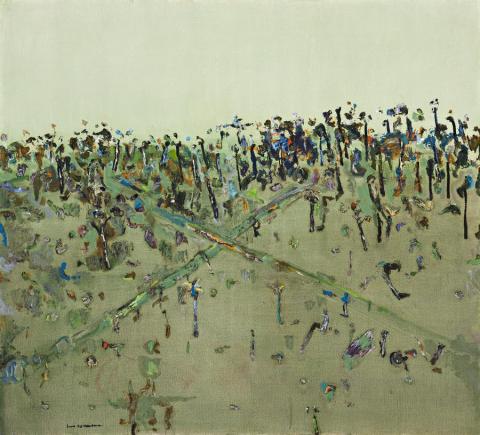ONE TREE HILL, 1968
FRED WILLIAMS
oil on canvas
101.5 x 112.0 cm
signed lower left: Fred Williams
Estate of the artist
Lyn Williams Collection, Melbourne
Rex Irwin Art Dealer, Sydney (label attached verso)
Private collection, Sydney
Mollison, J., A Singular Vision: The Art of Fred Williams, Australian National Gallery, Canberra, 1989, pp. 136–137 (illus. p. 136)
Fred Williams: A Retrospective, catalogue to accompany the touring exhibition, Australian National Gallery, Canberra, 1987, cat. 94, p. 17 (illus.)
Featured in the important Fred Williams retrospective exhibition curated by James Mollison for the National Gallery of Australia in 1987, One Tree Hill 1968 is a singular, major work in an oeuvre distinguished by individuality. It is the first painted in oils, out of doors, in his mature style. Moreover, the usual browns and ochres give way to greens celebrating the fecundity and regenerative powers of nature. On a winter's day in June 1968 Williams set out with his fellow artist Hal Hattam to paint in the Ferntree Gully National Park in the Dandenong Ranges. Later that day he wrote in his dairy, 'Down the track at the pond at F.T.G.N.P. find a very lovely spot - I had previously made several gouaches here and we work all day - in spite of drizzle. These are the first outdoor oils I have painted in many years! ... This has probably meant my closest look at a piece of country since the early days at Lilydale.'1 During the previous summer the fires that ravaged the Dandenongs nearly destroyed Williams's home at Upwey. The traumatic yet inspiring experience led him to paint the very moving bushfire series including such works as Burnt Landscape 1968 in the Gordon Darling collection. Back in his studio following the Ferntree Gully excursion, Williams painted the related oil One Tree Hill 1968-69, the dark presence of ashes placing this and our painting among the series which embraced the destructive and regenerative powers of nature. In One Tree Hill 1968, a painterly celebration of the latter, the emphasis is on abundance of growth. This he achieves through a range of rich colours and textures within the landscape, enveloped in a delicate mist of greens. By working directly from the motif, Williams was able to capture the transient winter drizzle with impressionistic verve, subtly expressing the rain falling from the sky across the land through the vertical movements of his brush.
A further feature which makes this painting unique in Williams's oeuvre is the prominent crossed tracks, the St Andrews Cross device which he used so frequently in later work as the structural girder upon which to hang his paint - much the same way the Cubists used the grid in their compositions.2 In One Tree Hill the cross is a prominent, realistic element within the landscape as well as being a masterly compositional device. While scholars have noted the greater realism of Williams's paintings of this time, they likewise acknowledged the growing maturity of Williams's visual language and masterly handling of paint. This can be seen in our painting in the use of the cross as both a prominent feature of the landscape and as a central part of the composition - a skilful blending of realism and reductive abstraction. The detail of the bush is rendered with textural daubs of colour-laden paint, conversely detailed and minimal. The forest landscape, crossed roads, horizon of trees and open sky are presented as an absorbing illusion of reality. But the wonder and beauty of the work lies above all in its formal and imaginative creativity, a work of art that happens to be of a landscape.
1. Williams's diary entry for 29 June 1968, as quoted in Mollison, op.cit., p. 137. Since 1987 the Park has been part of the Dandenong Ranges National Park.
2. See 'Fred Williams [painting] at Yan Yean, 1972', in McCaughey, P., Fred Williams, Bay Books, Sydney, 1980, fig. 158
DAVID THOMAS
